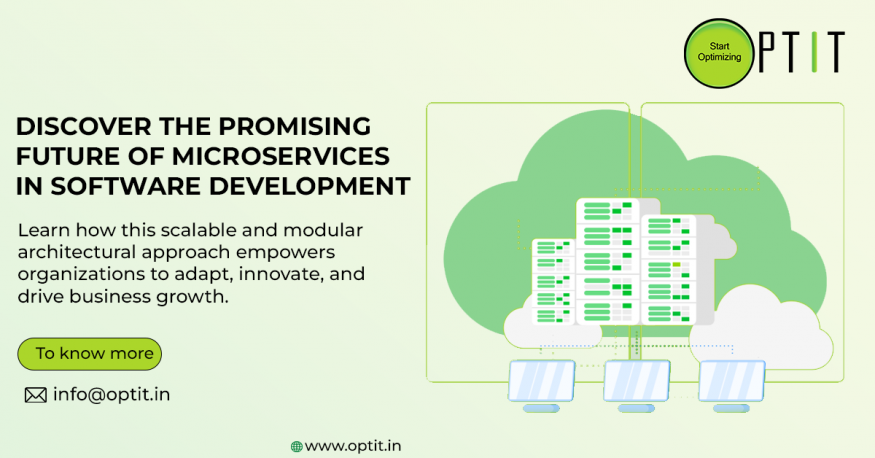
In recent years, microservices architecture has gained significant popularity as a robust and scalable approach to building modern software systems. As organizations strive for agility, scalability, and faster time-to-market, microservices have emerged as a viable solution. This article delves into the world of microservices, exploring their key benefits, challenges, and their promising future in the realm of software development.
Microservices represent a shift in software architecture from monolithic, tightly coupled systems to modular, independent services. Each microservice focuses on a specific business capability and can be developed, deployed, and scaled independently. This decoupling allows teams to work in parallel, enables flexibility in technology choice, and promotes easier maintenance and evolution of the system.
1. Scalability and Agility: Microservices architecture allows organizations to scale individual services independently, providing the ability to handle varying workloads efficiently. Teams can develop, test, and deploy services independently, fostering agility and reducing time-to-market.
2. Technology Diversity: Microservices offer the flexibility to choose different technologies, programming languages, and frameworks for each service. This enables teams to leverage the best tools for specific tasks, utilize existing expertise, and adopt emerging technologies seamlessly.
3. Continuous Delivery and DevOps: Microservices align well with DevOps principles, facilitating continuous delivery and rapid iteration. Services can be deployed and updated independently, enabling faster releases, easier rollbacks, and efficient testing and monitoring.
4. Resilience and Fault Isolation: In a microservices architecture, a failure in one service does not bring down the entire system. Services are isolated, allowing failures to be contained and minimizing the impact on the overall system. This enhances fault tolerance and system resilience
While microservices bring numerous benefits, they also introduce certain challenges that organizations need to address:
1. Distributed System Complexity: Microservices introduce distributed systems complexity, requiring robust service discovery, communication, and coordination mechanisms. Organizations must invest in proper infrastructure, monitoring, and governance tools to manage the complexities of a distributed architecture.
2. Data Consistency and Integration: Maintaining data consistency across multiple services can be challenging. Organizations need to design and implement proper data synchronization and integration mechanisms to ensure coherent and reliable data across the system.
3. Service Interdependencies: Microservices depend on each other to accomplish complex business processes. Managing dependencies and ensuring proper service orchestration can become complex, requiring careful planning and coordination.
Microservices have already transformed the software development landscape, and future looks promising. Here are a few areas where microservices are likely to have a significant impact:
1. Cloud-Native Architectures: Microservices align well with cloud-native principles and technologies such as containerization and orchestration platforms like Kubernetes. As organizations increasingly embrace cloud-native approaches, microservices will play a central role in building scalable, resilient, and cloud-ready applications.
2. Internet of Things (IoT): The growth of IoT devices and applications demands a flexible and scalable architecture. Microservices offer a modular and adaptable approach, allowing organizations to build IoT systems that can evolve with changing requirements and support millions of connected devices.
3. Machine Learning and AI: Microservices can facilitate the development and deployment of machine learning and AI algorithms as independent services. This enables organizations to leverage AI capabilities across various applications, making it easier to experiment, update, and optimize machine learning models in production.
4. Event-Driven Architectures: Microservices are a natural fit for event-driven architectures, where services communicate through events and messages. As organizations adopt event-driven paradigms to build reactive, real-time systems, microservices will play a key role in realizing the benefits of event-driven architectures.
Microservices have revolutionized the software development landscape, offering organizations a scalable, modular, and agile approach to building modern applications. With their ability to scale independently, embrace technology diversity, and enable continuous delivery, microservices empower organizations to adapt and respond to changing market demands swiftly. They offer resilience, fault isolation, and improved fault tolerance, making systems more robust and reliable.
As technology evolves, microservices will continue to play a vital role. Cloud-native architectures, IoT, machine learning, AI, and event-driven architectures are just a few areas where microservices are poised to make a significant impact. Their ability to provide modularity, scalability, and flexibility positions microservices as an ideal architectural choice for these emerging trends.
However, it’s essential to acknowledge the challenges associated with microservices, such as distributed system complexity and data consistency. Organizations must invest in the right tools, infrastructure, and governance mechanisms to overcome these challenges effectively.
By embracing the power of microservices, organizations can unlock a vast array of opportunities, enabling them to build robust, scalable, and future-proof applications that foster innovation and drive business growth.
In conclusion, the future of microservices is bright. By embracing this architectural style, organizations can leverage the benefits of scalability, agility, and technology diversity. As technology continues to evolve, microservices will remain at the forefront of modern software development, empowering organizations to build cutting-edge applications that meet the demands of today’s dynamic and ever-changing market.